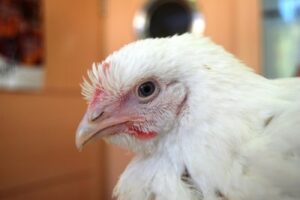
In queste ore ha postato su Facebook un video agghiacciante dove, in un paese straniero (a giudicare dal parlato), all'esterno di un allevamento avicolo viene posizionato un infernale macchinario che in pochi secondi uccide i polli, rendendone da una parte la carne e dall'altra interiora e altro. Quello che pare uno scherzo di dubbio gusto è (purtroppo) vero: i polli finiscono per essere ammazzati senza un evidente stordimento con una procedura che, ancora una volta, pare irrispettosa degli animali, oltre che del buon gusto. Al punto che è possibile udire i lamenti delle sfortunate bestiole provenire dal terribile macchinario. Per non urtare la sensibilità dei lettori evitiamo di postarne il link.
"Volete un pollo arrosto a casa vostra a 6/8 €? Una lonza di maiale a 2,99 €? una fiorentina a 9,99€? Questo è l'unico modo - scrive in un post Bigi -. Noi produttori siamo più cari, è vero, ma..... non facciamo queste cose. Un pollo bio costa di più".
Una lettrice scrive: "Quando avevo le galline le chiamavo per nome, e mi rispondevano, a vedere questo mi sono rovinata la giornata..."








Possiamo discutere, e molto, sulla industrializzazione della nostra alimentazione però magari è bene fare chiarezza sul caso specifico.
Il macchinario nel video è di una ditta finlandese: questo qui se vi interessa: http://www.petsmoproducts.fi/en/tuotteet-chick-pulp/.
Serve per macellare le galline ovaiole alla fine del loro ciclo produttivo.
Non le macella vive ma appena entrano nella macchina vengono uccise con la C02 ed essendo un macchinario mobile evita lunghi viaggi in camion alle galline e quindi in un certo senso ne diminuisce “lo stress”. http://www.redacon.it/wp-admin/edit-comments.php#comments-form
E’ uno dei sistemi considerati più “umani” dalle legislazioni sul “welfare animale”. (http://www.awfc.ca/english/works/pub/disposehens.htm)
Il risultato della macellazione non viene utilizzitato per produrre cibo per l’uomo ma al massimo finisce nel cibo per cani e gatti (sono cavoli loro).
Insomma la realtà è spesso complessa e non prendiamocela troppo con il Chick Pulp.
(Vezzano.net)
1) -Dear Sir
I quote from the site reported that you has:
“HUMANE ISSUES SURROUNDING SPENT HENS AND THEIR DISPOSAL
The disposal of spent laying hens raises a number of concerns regarding their humane treatment. Spent laying hens tend to be physically fragile by the end of their laying cycle.
Removal from cages can cause painful injuries due to the fragility of their bones and the poor design of older cages. Transportation to processing plants can expose hens to
inclement weather conditions over long hauling distances. Market variability affects the economic value of spent hens, sometimes challenging producers to find more economically
feasible means of destroying spent flocks. These three issues – fragile bones, transportation and market variability – interact to create circumstances which can gravely affect the
humane disposal of spent laying hens.
Osteoporosis
Osteoporosis, or thinning of the bones, in laying hens is a concern recognized by the researchers and producers alike. Fragile bones in laying hens can result in bone fractures
during catching and transportation. Osteoporosis in laying hens is generally attributed to lack of exercise or weight bearing, and the heavy demands for calcium during eggshell
formation. Lack of weight bearing is known to weaken and reduce bone mass, thereby increasing the incidence of broken bones during handling. Calcium demands on laying hens can be
difficult to meet. Research into dietary means of reducing osteoporosis have shown that while a good diet can minimize bone fragility, it cannot prevent osteoporosis.
Research into the incidence of broken bones in hens has reinforced welfare concerns. Between 24% and 29% of laying hens, on average, experience broken bones by the time they reach
the processing plant, according to one study done in 1989.2 Bone breakage in spent laying hens is a humane issue because it is reasonable to assume that such injuries cause pain to
the animals involved. It is important to note that catching methods can greatly reduce the incidence of broken bones.3 Any method that aims to improve upon the humane disposal of
spent hens must take into account the risks involved with handling fragile birds.
Transportation
Due to the generally low economic value placed on spent laying hens, the number of processing plants willing to accept them is limited. This can mean that producers are forced to
transport their spent flocks over long distances to an available processing plant. Transportation distances of 80 to 800 kilometers are common with economic circumstances justifying
trips upwards of 2,400 kilometers at times. This translates into transportation times of 6 to 10 hours for hens travelling 500 to 800 kilometers. These transportation times do not
include loading and unloading time, which can be from 2 to 4 hours at each point. One study in Canada found that interprovincially transported hens were in transit for 26 hours,
while locally transported birds took 18 hours to reach the processing plant. “Dead on arrival” (DOA) and condemnation rates (meat condemned by inspectors) can vary. There is a
general positive correlation between numbers of DOA and condemned birds, and time spent in transit, particularly in winter months.4 Excessive heat or cold, previous injuries,
vehicle vibration, noise and light likely combine to stress spent hens fur ther during their transportation to the processing plant.”
Incredible: from my point of view we want also limit to hypocrisy.
2) “ll risultato della macellazione non viene utilizzitato per produrre cibo per l’uomo ma al massimo finisce nel cibo per cani e gatti (sono cavoli loro). “:
No comment.
Yours faithfully.
(Giovanni Annigoni)
NOTA DELLA REDAZIONE: Gentile Annigoni, capiamo la comodità del copia e incolla e dei traduttori. Però un sunto e soprattutto una traduzione in italiano può agevolare di molto la comprensione del suo pensiero o delle informazioni in suo possesso nei confronti dei lettori. Best wishes
Io ho visto quel video e mi sono fermato a 1.34 perché mi veniva il rigetto, sarà perché sono vegetariano ma penso che solo l’uomo può commettere queste brutalità, è ora di cambiare anche il settore dell’alimentazione e soprattutto i consumi alimentari.
(Luca Malvolti)
che schifo , sarà difficile mangiare pollo
(Annamaria)